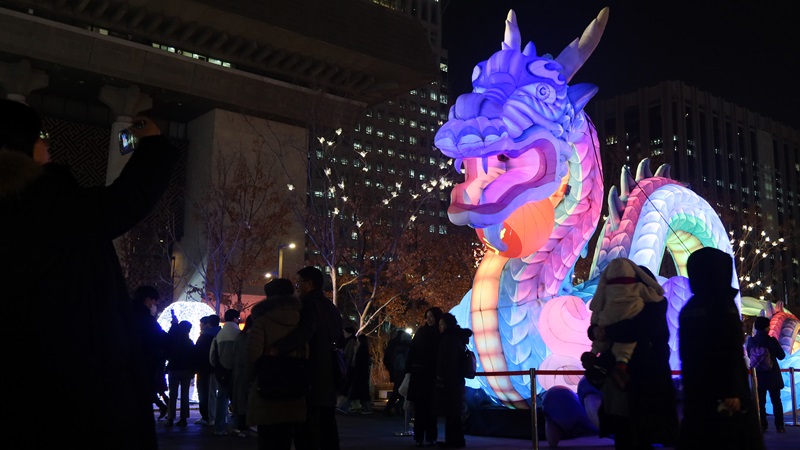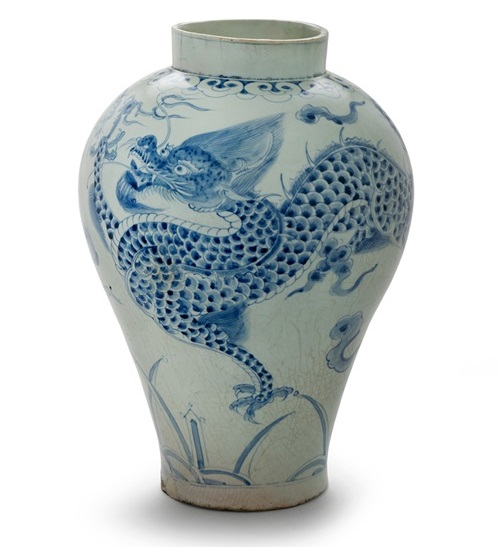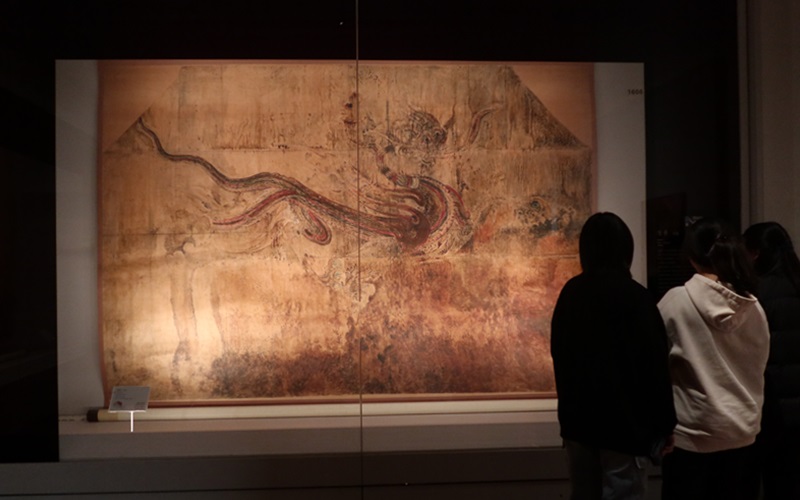
한국에는 해마다 그 해를 상징하는 동물이 있다. 통일신라시대부터 12마리의 동물(쥐, 소, 호랑이, 토끼, 용, 뱀, 말, 양, 원숭이, 닭, 개, 돼지)에 따라 한 해의 운을 미리 짐작해 보거나 덕담을 나눴다.
A distinct animal marks each year in Korea under the Asian zodiac. Since the Unified Silla period (676-935), the 12 zodiac signs — the mouse, ox, tiger, rabbit, dragon, snake, horse, goat, monkey, rooster, dog, and pig — symbolize each year in that order as the criterion for predicting the given year’s fortunes and exchanging good wishes.
2024년은 육십갑자 중 41번째에 해당하는 갑진년(甲辰年)으로, 천간 중 청색에 해당하는 ‘갑'(甲)과 지지 중 용에 해당하는 ‘진'(辰)이 만난 푸른 용의 해다.
2024 is gabjinnyeon (Year of the Blue Dragon), the 41st year of the 60-year cycle. Gab (yang or blue) is one of the 10 Heavenly Stems marked by the color blue. Jin refers to “dragon,” and thus this year marks the Year of the Blue Dragon. The stems are formed by combining the five elements of wood, fire, earth, metal and water with the two opposing forces of yin and yang.
십이지신 중 유일한 상상의 동물인 용은 낙타 머리에 사슴 뿔, 토끼 눈, 소의 귀, 뱀의 목, 개구리 배, 잉어 비늘, 매 발톱, 호랑이 발을 가졌다고 전해진다.
As the only imaginary animal among the 12 in the zodiac, the dragon is said to have the head of a camel, antlers of a deer, eyes of a rabbit, ears of an ox, neck of a snake, belly of a frog, scales of a carp, claws of a hawk and feet of a tiger.
한국 속담 ‘비바람 따라 구름 가고, 구름 따라 용도 간다’처럼 용은 비와 물을 상징하며 수신(水神), 우신(雨神) 등으로 여겨졌다. 조상들은 농사에 필요한 물을 얻고 바다에 나가 물고기를 잡기 위해 용에게 안녕을 빌었다.
Like the Korean proverb “The cloud follows the storm and the dragon follows the cloud,” the dragon symbolizes both rain and water as the god of both. Koreans in ancient times prayed to dragons for the water they needed for agriculture or to catch fish in the sea.
용은 강력한 힘을 의미하기도 했다. 왕의 얼굴을 용안(龍顔)이라고 불렀고 왕의 옷과 허리띠, 앉는 의자를 항상 용으로 장식했다.
The dragon also symbolizes strong force. The king’s face was called yongan, which literally translates to “dragon face,” and his clothes, belt, and chairs had dragon designs.
청룡은 동서남북 네 방위 중 동쪽을 지키는 수호신으로 여겨져 고구려 고분이나 백제 고분 등에 나타난다. 서울 종로구 흥인지문과 중구 숭례문 홍예 천장에서도 볼 수 있다.
As one of the four guardians of north, south, east, and west, the blue dragon protects the east and its symbols were used in the tombs of the Goguryeo Dynasty (37 B.C.-A.D. 668) and Baekje Kingdom (18 B.C.-660 A.D.). The creature is also seen on the ceilings of Heunginjimun (Dongdaemun) Gate in Seoul’s Jongno-gu District and Sungnyemun (Namdaemun) Gate in Jung-gu District.
국토지리정보원의 2021년 통계자료에 따르면 전국 고시 지명 약 10만 개 중 열두 띠 동물 관련 지명은 4109개(4.1%)이며 이중 용 관련 지명이 1261개로 가장 많았다.
Among the approximately 100,000 registered regional names nationwide, 4,109 (4.1%) are related to the 12 zodiac animals, according to data from the National Geographic Information Institute in 2021. Among the latter, those related to the dragon were the most common with 1,261.

용의 해를 맞아 용이 지닌 문화적 상징과 의미를 소개하는 전시회가 서울에서 개최된다. Seoul is hosting exhibitions to promote the dragon’s symbolism and significance to mark gabjinnyeon.
서울 종로구 국립민속박물관에서는 오는 3월 3일까지 ‘용(龍), 날아오르다’ 특별전이 열린다. 조선 18세기 백자청화운룡무늬항아리, 운룡도, 용 무늬 목판 등을 통해 역사 속 용의 의미를 살펴볼 수 있다. 또 1973년 5월 5일 운행을 시작한 한국 최초 롤러코스터인 청룡열차를 체험할 수 있는 코너도 마련됐다.
Through March 3, the National Folk Museum of Korea in the capital’s Jongno-gu District holds the exhibition “The Blue Dragon.” An 18th-century blue-and-white porcelain vase from the Joseon Dynasty with a cloud and a blue dragon, paintings of dragons and clouds, woodblocks engraved with dragon images and others show the meanings of the mythical creature throughout the nation’s history. Another section allows visitors to see Cheongnyong (Blue Dragon) Train, Korea’s first rollercoaster opened to the public on May 5, 1973, at Children’s Grand Park in the city’s Gwangjin-gu District.
서울 용산구 국립중앙박물관에서는 ‘갑진년맞이 용을 찾아라’ 전시가 4월 7일까지 열린다. 고구려 강서대묘의 ‘청룡도’, 조선 19세기 ‘운룡도’, 18세기 후반 백자 청화 구름 용무늬 항아리 등 다양한 형상의 용과 관련된 전시품 15건이 소개된다.
The National Museum of Korea in Seoul’s Yongsan-gu District until April 7 runs the exhibition “Finding Dragons at the Museum.” Displayed are 15 dragon-related works including a painting of a blue dragon on Gangseodaemyo (Gangseo Great Tomb) from the Goguryeo era, another of a dragon and clouds from the Joseon period in the 19th century, and white porcelain with blue designs of a dragon and clouds from the late 18th century.

서울 = 홍안지 기자 shong9412@korea.kr
By Hong Angie, shong9412@korea.kr
